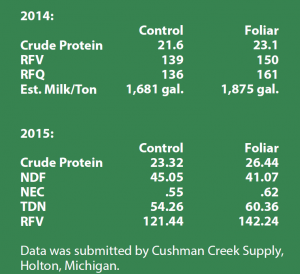

Hay Quality can be easily improved with foliar nutrients following each cutting
At ISP, the first step in assembling a crop recommendation is to study the crop and how it grows. From standing alfalfa, we’ve identified several key aspects of plant physiology that will have a significant impact on both tonnage and quality. First, is to ensure that crown health (or vigor) is maintained. MetaboliK HV-1 has shown for several decades to aid with crown vigor, encouraging an increase in the number of vegetative shoots that initiate following each cutting.
Second is to understand that once you have removed the previous cutting of hay, there is at most three weeks before it will be time to cut hay again. This being the case, it is imperative that the crown begins to aggressively initiate and grow new vegetation. Last, is that quality hay is determined by both protein and trace mineral content. By far the most effective way to maintain animal health is to feed forage and/or grain that has high mineral content. Alfalfa is a cool season legume grown in many parts of the world. Optimum day and night temperatures are 80/70 and growth is slowed considerably once temps are in the 90’s. It requires high levels of both water (from 4” to 5” per ton of hay) and nutrient to achieve maximum potential. Soil type, and depth of the soil, will also have a significant impact upon both hay quality and stand longevity.
It’s a crop that we’ve studied since the 80’s and we believe we have a number of applications that will benefit your alfalfa. One option that has consistently shown positive results is a foliar application of 8-10 lbs./ac. Of 28-16-7 Alfalfa, with 6 ounces of MetaboliK HV-1. This should be applied as soon as the hay has been removed, assuming there is adequate soil moisture to support aggressive regrowth. The 28-16-7 Alfalfa has a different secondary and trace mineral formulation than our standard 28-16-7, as it has been specifically formulated for alfalfa.

This program has shown positive benefits in research field trials in Colorado, Indiana, Michigan, Ohio, and Pennsylvania. Yield increases are common, although it should be noted that this increase is more the result of an increased number of vegetative shoots from the crown, producing a “thicker” stand, rather than an increase in overall plant height.
Other common observations include a more solid stem, more numerous and larger leaf structure, and an increase in feeding quality.
